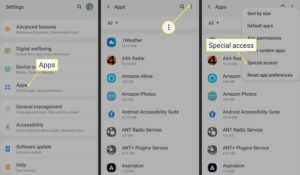Should You Disable ConfigApp? Android Mystery App Explained!
Introducing ConfigApk: Unraveling the mystery
In the vast and ever-expanding universe of mobile applications, few manage to arouse interest and confusion like ConfigApk. With pre-installed encryption, this app sits almost unnoticed, quietly in the corner of your device’s app list. But what exactly is ConfigApk? Today we delve into the origins of this mysterious project, shedding light on its purpose, the excitement surrounding its existence, and whether it’s something you should be thinking about.
What is ConfigApk?
ConfigApk is still an integral part of the Android operating system, basically acting as a utility to configure applications after installation or their updates It works silently in the background, ensuring apps are properly configured, licensed as needed , and all activities are managed without interruption This is the staff behind the stage, ensuring that the show goes on without any technical glitches.
Despite its primary role, ConfigApk remains a silhouette for many users, mainly because it works in the background, away from direct user interaction. It’s not an app you open and use like you do Instagram or WhatsApp. Instead, it does its job imperceptibly, contributing to the seamless experience you enjoy on your Android device.
Should you worry about ConfigApk?
The question of whether ConfigApk is a concern is a teaser that we will discuss more in the following sections. However, in the meantime it’s important to note that understanding the role and origins of an app is key to demystifying its presence on your device. With the curtain raised on what ConfigApk should do, the next step is to thoroughly examine its actions, if any, and its requested permissions to ensure that they match the expectations of a system utility executed previously entered matches
What is ConfigApp and what does it do?
When we venture into the world of mobile applications, there’s what we download for fun, work, or socializing, and then there’s what works behind the scenes, which is important but we don’t notice. ConfigApp belongs to the last category. Unlike mainstream applications, its functionality is key to the smooth running of your device but remains largely invisible to the user. Let’s explore what ConfigApp is and its basic functionality in an easy to digest format.
Explaining ConfigApp in Simple Terms
At its core, ConfigApp is a system utility. Its primary role is to ensure that other applications on your device are correctly set up and can run as intended. Think of it as the backbone supporting other apps, helping them to integrate seamlessly with your device’s software. Its activities include:
- Setting up new applications: When you install a new app, ConfigApp works in the background to configure it according to your device’s specifications.
- Updating applications: It also plays a part in the update process, making sure that any changes are compatible with your current system setup.
Functions Depending on the Device Manufacturer
While the primary purpose of ConfigApp remains the same—ensuring the smooth operation and setup of other applications—its specific functionalities can vary slightly depending on the device manufacturer. This is because different manufacturers might tweak the Android OS to align with their vision, often adding unique features or customizations. As a result, ConfigApp might be responsible for:
- Customization Settings: On some devices, ConfigApp might handle the application of themes or other customization settings to third-party apps, making sure these personal touches do not interfere with app performance.
- System Configurations: It may also manage system-level configurations, ensuring that updates or new installations do not conflict with the device’s core functionalities.
Is ConfigApp Safe?
In a world where digital safety has become an increasingly dominant concern, it is perfectly natural to question the security aspects of any app residing on your device, especially one as elusive as ConfigApp. Let’s unravel the safety dimension of ConfigApp, from its inherent security stature to how you can distinguish a legitimate ConfigApp from potential malware.
Security Concerns Related to ConfigApp
As a part of the Android operating system, ConfigApp is, by design, safe and critical to your device’s seamless performance. The core function of the app—to manage the configurations of other apps on your device—doesn’t inherently pose any security threats.
However, like any app, ConfigApp’s safety also depends on its source. If it’s from a trusted manufacturer—typical of Android devices—the risk is minimal. The App came pre-installed with your device, designed to perform its critical operations silently in the background.
Legitimate ConfigApp Vs. Potential Malware
While the authentic ConfigApp is generally harmless, it’s prudent to be aware of potential imposters. Here are some signs to help distinguish a legitimate ConfigApp from potential malware:
- Source of the App: If ConfigApp is pre-installed on your device, it’s most likely the legitimate utility from your Android operating system. However, if you find that it has been installed from an unknown source or popped up out of nowhere, it may signal suspicious activity.
- App Behavior: True ConfigApp doesn’t involve user interaction, nor does it send notifications or use up noticeable device resources. If you discover an app named ConfigApp consuming significant battery, sending peculiar notifications, or demanding unusual permissions, that would warrant further investigation.
- Device Performance: Legitimate ConfigApp works to improve the performance of your device, not hinder it. If you observe performance issues such as lag or frequent crashes, coupled with peculiar ConfigApp behavior, it might be time for a malware check.
Should You Disable ConfigApp?
The ConfigApp on your Android device serves quietly in the background, but there may come moments when you wonder if you should disable it. This section will help you weigh that decision by presenting the advantages and disadvantages of disabling ConfigApp.
Pros of Disabling ConfigApp
- Free Up Storage Space: If your device’s memory is running low, disabling system apps that you don’t use might help reclaim some storage space. ConfigApp is generally quite small, but every bit counts.
- Reduce Security Vulnerabilities: If the app isn’t from a trusted source or manufacturer, disabling it could reduce potential security risks. This is particularly relevant if you’re not sure how ConfigApp was installed on your device.
Cons of Disabling ConfigApp
- Impact on User Experience: ConfigApp has a role in the proper functioning of your device. Disabling it might lead to operational issues or a decline in user experience due to malfunctioning apps that depend on ConfigApp for their configuration.
- Pre-installed and Safe: The genuine ConfigApp, when provided by a reputable manufacturer, is not harmful. Disabling it doesn’t necessarily enhance your device’s security and could lead to other issues.
In short, here’s what to consider when deciding whether to disable ConfigApp or not:
- Storage Space: Will disabling it significantly free up your device’s storage?
- Functionality: Are you prepared for the possibility that disabling it might affect how other apps run on your device?
- Security: Are you certain that the ConfigApp on your device is secure, and that disabling it is not necessary to protect your device?
How to Disable ConfigApp (If Necessary)
If you’ve decided that disabling ConfigApp is necessary for your device, follow this step-by-step guide to do so. Please note that disabling system apps is not always straightforward and may involve risks, including reduced functionality or the need to modify your device’s default settings.
Step-by-Step Guide for Disabling ConfigApp
For Users with a Standard Device Setup:
- Access Settings:
- Open the ‘Settings’ app on your device. You can find it in your app drawer or on your home screen.
- Navigate to ‘Apps’:
- Scroll down within settings and tap on ‘Apps’ or ‘Application Manager’ to access the list of all installed apps.
- Find ConfigApp:
- In the list of apps, look for ‘ConfigApp’ or a similar name. Some devices may require you to tap on ‘Show system apps’ or ‘System processes’ to reveal it.
- Open App Info:
- Tap on ‘ConfigApp’ to open its App Info screen.
- Disable the App:
- Look for a ‘Disable’ or ‘Turn off’ option. If available, tap it. Confirm your choice if prompted.
For Devices Where Disabling is Not Straightforward:
Caution: Disabling system apps on devices that don’t natively allow it can be risky and may require advanced operations like rooting your device, which voids warranties and can lead to permanent damage.
- Developer Options:
- Enable ‘Developer Options’ by going to ‘Settings’ > ‘About phone’ and tapping on ‘Build number’ seven times.
- OEM Unlocking:
- In ‘Developer Options’, toggle ‘OEM unlocking’ to allow modifications to system software.
- Root the Device:
- Use a trusted rooting method suitable for your device model. This step is complex and should only be performed by experienced users or professionals.
- Use a System App Remover:
- Once rooted, you can use a third-party app like ‘System App Remover’ to disable or remove ConfigApp.
Important Points to Remember:
- System apps are essential for your device’s functionality. Disabling them could cause other apps to malfunction.
- Rooting your device can void the warranty and may render it unusable if not done properly. It is generally recommended only for advanced users.
- Always back up your data before making any significant changes to your device’s software.
Alternatives to Disabling ConfigApp
Before deciding to disable ConfigApp on your device, it’s worth exploring some alternatives that might help you manage the app without the need to entirely disable it. Remember, ConfigApp plays a role in configuring your device’s apps, particularly after updates or installations, so careful consideration is advised.
Managing ConfigApp’s Background Activity and Data Use
- Restrict Background Activity: Limit ConfigApp’s ability to run in the background through your device’s settings. This can conserve battery life and reduce unnecessary data usage.
- Control Data Usage: If you’re concerned about ConfigApp using too much data, you can set restrictions on how much data the app can use from the settings menu of your device.
conclusion
ConfigApp is a system application found on many Android devices, which is basically responsible for configuring other apps, especially after an update or when it is first installed. Given its primary functionality, the decision to disable ConfigApp or not depends on individual needs and the functionality it provides.
Remember, stopping ConfigApp can free up storage and can reduce security vulnerabilities, but it can also affect the performance of other applications. Activation should be selected based on careful consideration of these factors.



